Categories: All about LEDs
Number of views: 38618
Comments on the article: 0
Types of LEDs and their characteristics
LED lighting is by far the most efficient, and in this context it is not at all surprising that LEDs undergo a certain evolution year after year. Their power is becoming more and more, buildings are being optimized for various purposes, not to mention the color of the emitted light.
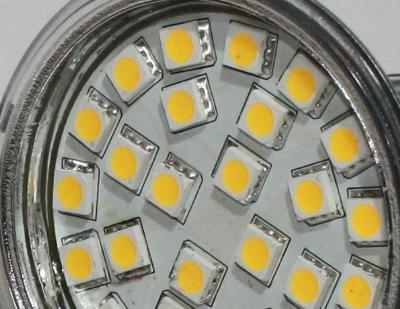
The color can be almost any, it is enough for the manufacturer to choose the appropriate composition of the semiconductor and dopants, so that the band gap for the recombination of electrons and holes gives the desired color.
Meanwhile all modern LEDs can be classified to some extent by type, that is, by the most distinctive distinguishing features, which we will do - we will consider several types of the most common LEDs, from indicator to lighting. By the way, it can immediately be noted that the LED started its evolution by and large from an indicator ancestor.
Indicator LEDs for output mounting
To this day, indicator LEDs with a round or rectangular lens can be found anywhere, from the chargers of mobile gadgets to the indicators of complex medical equipment. Even indicator lights are sometimes used as lighting LEDs, but such solutions have been found less and less recently.
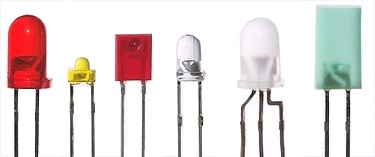
Indicator LEDs with convex round lenses with a diameter of 3, 5, 8 and 10 mm are characteristic representatives of this type. By the way, it was with them that such a direction in semiconductor technology started as lighting LEDs (for flashlights, for example). However, the current of the indicator LED will not allow to get enough light, and on an industrial scale it is simply not advisable to use such LEDs for lighting, especially today.
They are suitable for indicators, even LED displays and tickers collected only one time from such LEDs for lack of an alternative. Small indicator LEDs are slightly warm and at least somehow light up - what else is needed from the indicator .. Voltage from 2.5 to 5 volts at a current of 10 to 25 milliamps - no more.
Colors: white, red, orange, yellow, green, blue, violet, ultraviolet. Indicator LEDs come in and multicolor rgbwhen three transitions are hidden under one lens, and there are four outputs at the bottom, that is, the indicator will turn out to be more functional, and the LED display will be colored (see - The use of LEDs in electronic circuits).
The solid angle of dispersion is up to 140 degrees for a rectangular lens, and up to 130 degrees for a round lens. The brightness of the indicator LED is from 100 to 1000 millikandels on average.
Bright LEDs for output mounting

Behind the indicator LEDs, bright LEDs appeared with round lenses up to 10 mm in diameter, which have already become widely used in flashlights. When consumed up to 30 mA at 2 - 4 volts of power, the power of their light reaches 5000 millikandel.
LED indicators and lighting SMD (Surface Mounted Device)
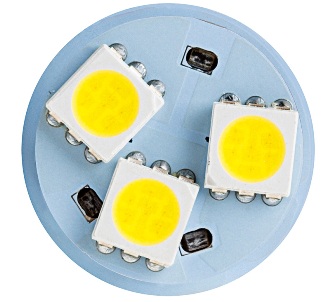
This type of indicator LEDs is designed specifically for surface mounting on a printed circuit board. Such LEDs are available in standard SMD enclosures, ranging in size from 0603 to 7060, with sizes from 1608 to 3528 being the most common. The visible solid angle is from 20 to 140 degrees, and the average brightness is 300 to 400 millikandels.
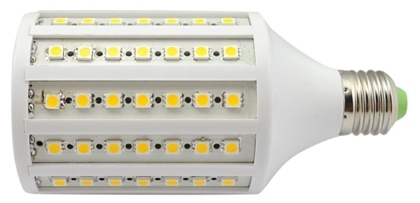
Their power characteristics are similar to indicator LEDs of output mounting. Nevertheless, surface-mounted LEDs can be mounted on a board in large quantities over a small area, and in this way you can get an LED lamp or light panel of any size. LED strip - also a set of SMD LEDs on the substrate.
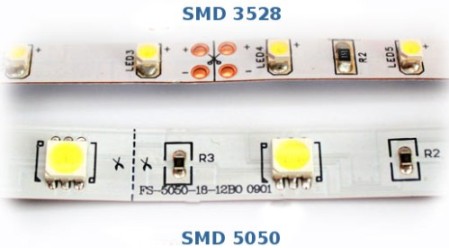
Piranha LEDs

A special group of LEDs that are widely used in the advertising industry and in auto-tuning are ultra-bright Piranha LEDs of a rectangular shape. LEDs are distinguished by a special form of the base, and improved scattering properties. They are conveniently and rigidly attached with four leads to a printed circuit board or to another flat base.
Colors: white, red, green and blue. Sizes - from 3 to 7.7 mm. Due to the substrate of a larger area and high thermal conductivity, the current through the LED can reach up to 50 mA at a voltage of up to 4.5 volts. The scattering angle reaches 120 degrees or more.
Lighting LEDs COB (Chip On Board)
LED lighting is the widest range of LED applications today. The radiation can be warm and cold, white, yellow or any other shade, similar in color to fluorescent lamps, incandescent lamps, or even sunlight, depending on required color temperature, and mainly at the production stage, - from the composition of the semiconductor and phosphor.
The most common way to make lighting LEDs is to apply a phosphor to a blue LED. As a result, the light emitted by the LED is obtained in yellow, green, red, etc. The light is close in property to luminescent.

COB LEDs are a variety of semiconductor crystals mounted on the same substrate, and filled with a phosphor. As in the case of mounting several SMD LEDs on the board, a similar result is obtained here - high brightness due to the total luminous flux from several small light sources. But sources (crystals) are located denser on the substrate, therefore, the luminous flux is obtained more than when installing SMD on the board.
COB LEDs are of course also suitable as indicators. Lighting equipment, in turn, has become much cheaper with COB LEDs, not only because of the automation of the manufacturing process, but also due to more economical application of materials.
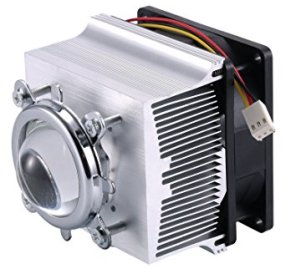
It is important, however, to always remember that such an LED needs to provide the necessary heat dissipation, and a powerful and very powerful (from 3 to 100 watts) requires a radiator, otherwise there will be rapid thermal destruction of the crystals.
It is impossible to repair such a COB matrix, and if some of the crystals deteriorate, you will have to change the entire substrate to a new one, so it is better to immediately create acceptable conditions for it in terms of cooling.
The power parameters, as a rule, are from 3 to 35 volts, depending on the specific model, and the current is from 100 mA to 2.5 A and even more.
Filament LEDs (filament shaped)

This type of LED has even better lighting properties than COB. Many crystals are mounted on a glass substrate, then they are filled with a fluorescent composition. The technology is called Chip On Glass - a chip on glass.
The visible solid angle is 360 degrees, and that’s why light output is superior to matrices with flat substrates. One 6-watt lamp based on filament LEDs corresponds to a 60-watt incandescent lamp in terms of the amount of emitted light.
In general, all the LEDs on the market cannot be clearly and more accurately classified, because there is a process of evolution of semiconductor light sources, and some are a variety of others. LED strips are essentially SMD LEDs on a substrate, and LED indicators are a set of indicator LEDs. Therefore, our brief overview of the most expressive positions is completed.
See also on this topic:Powerful LED arrays in lighting (device and application features)
See also at bgv.electricianexp.com
:
